Healthy and Quick School Meal Ideas for Kids in America— without spending hours in the kitchen.
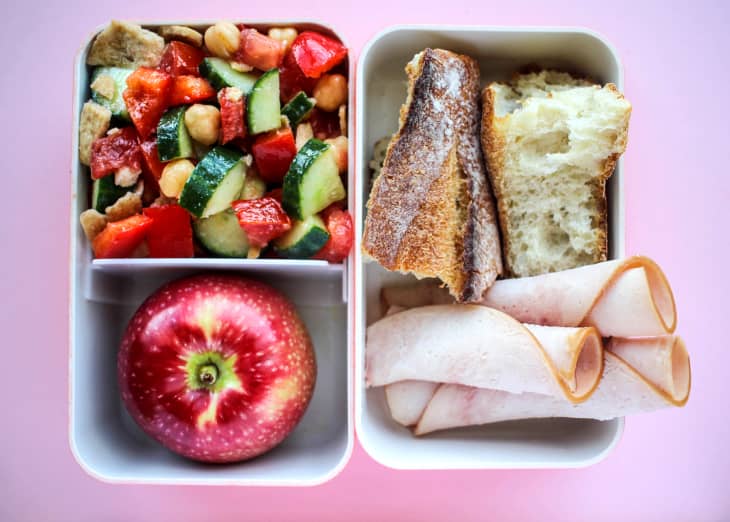
Packing school lunches every morning can be one of the most repetitive parenting tasks — but it doesn’t have to be boring or stressful For many parents, the goal is simple: create healthy and quick school meal ideas for kids in America that balance taste, nutrition, and variety.
As a mom of two boys and a trained nutritionist, I’ve learned that the key to success lies in balanced school lunch ideas with protein and veggies, rotating familiar favorites with small doses of new foods, and streamlining the process with smart, time-saving hacks.
In this guide, you’ll find my ultimate framework for building nutritious and easy lunchbox recipes for kids, tips for introducing new foods without a lunchtime revolt, and over 60 practical food options to mix and match throughout the school year.
Why Balance Matters in Kids’ School Lunches
When I pack a lunchbox, I’m not striving for perfection. My focus is on balanced lunch for kids that covers multiple food groups and keeps them energized until the last school bell rings.
I mentally run through what I call the “Big Six” categories:
-
Protein – for sustained energy and focus
-
Fruit – for vitamins, fiber, and natural sweetness
-
Vegetables – for minerals and healthy digestion
-
Dairy or Plant-Based Alternative – for calcium and protein
-
Crunchy Snack – for texture and fun
-
Sweet Treat – because balance includes a little joy
This approach ensures quick and balanced kids school meals with variety, covering different nutrients, textures, and flavors.
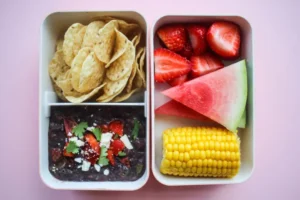
Building Blocks: Protein-Packed Lunches That Keep Kids Full
Protein is the anchor of every healthy school lunch. It helps maintain focus and prevents the mid-afternoon slump.
Some of my favorite easy protein-packed lunch ideas for children include:
-
Turkey roll-ups on whole grain tortillas
-
Tuna salad with diced celery and cranberries
-
Mini chicken or turkey meatballs
-
Greek yogurt with berries
-
Pasta salad with white beans
-
Hummus with pita chips or veggie sticks
-
Baked tofu with teriyaki sauce
When kids can dip, stack, or assemble their food such as hummus with carrots or tuna with crackers — lunch becomes more interactive, which increases the chance they’ll eat it.
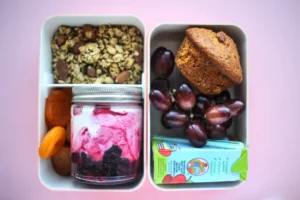
Fruits and Veggies: Color and Variety Kids Love
Introducing kid-friendly fruits and vegetables for lunchboxes early can build lifelong healthy habits.
Fruits that travel well:
-
Berries (strawberries, blueberries, raspberries)
-
Apples (sliced with lemon juice to prevent browning)
-
Grapes (halved)
-
Oranges, mango, kiwi
-
Dried apricots, cranberries, or raisins for a chewy alternative
Veggies that are lunchbox favorites:
-
Carrot sticks
-
Cucumber slices
-
Bell pepper strips
-
Cherry tomatoes (halved)
-
Snow peas
-
Avocado sprinkled with seasoning
Rotating these options prevents boredom and keeps lunch colorful.
Dairy and Dairy-Free Alternatives
Some kids love yogurt, others prefer cheese sticks. For dairy-free families, plant-based options like almond yogurt or vegan cheese slices work just as well.
Popular dairy alternatives for kids include:
-
Dairy-free yogurt with frozen blueberries
-
Bagels with vegan cream cheese
-
Plant-based cheese cubes
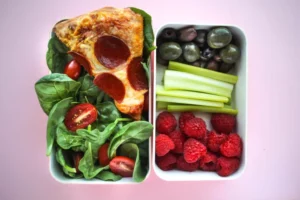
Crunchy Snacks and Sweet Treats — Without the Guilt
Every lunchbox needs something fun Healthy kids snacks can be both satisfying and nourishing:
-
Whole grain crackers
-
Pretzel sticks
-
Goldfish or Pirate Booty
-
Veggie straws or nori seaweed snacks
For sweets, I believe there are no “bad” foods — just balance. My go-to sweet treats for kids lunches include:
-
Dark chocolate-covered raisins
-
Mini cookies
-
Yogurt-covered pretzels
-
Fruit leather
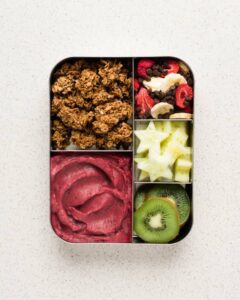
Introducing New Foods to Picky Eaters
When introducing a new food, avoid making it the star of the lunchbox Pair it with favorites they already love.
For example:
-
Add roasted chickpeas next to Goldfish crackers
-
Include kiwi slices alongside strawberries
-
Serve cucumber with a small side of ranch
This method helps picky eaters become familiar with new flavors without pressure — a strategy that’s key for introducing new foods to kids.
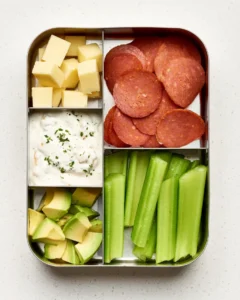
Time-Saving Hacks for Busy Mornings
Many parents need time-saving tips for packing school lunches to make mornings less stressful:
-
Lunchbox Pantry Basket – Keep pre-portioned snacks ready to grab.
-
Weekend Prep – Wash and slice produce in bulk.
-
Dinner Leftovers – Repurpose cooked protein and veggies into wraps, salads, or pasta dishes.
These tricks make it easy to prepare creative and healthy lunchbox ideas for busy parents without reinventing the wheel each morning.
Sample Mix-and-Match Lunchbox Combinations
Here are a few nutritious school meals using the Big Six formula:
-
Turkey roll-ups + grapes + carrot sticks + cheese cubes + pretzels + mini cookie
-
Pasta salad with beans + strawberries + cucumber slices + yogurt + crackers + fruit leather
-
Tuna salad with crackers + orange wedges + bell pepper strips + plant-based yogurt + veggie straws + dark chocolate raisins
By rotating combinations, you create school lunch ideas that never feel repetitive.
Kids Who Enjoy a Wide Range of Foods
At the end of the day, my aim isn’t an empty lunchbox every time — it’s raising kids who feel comfortable with a variety of foods With healthy and quick school meal ideas for kids in America, variety becomes the norm, and healthy eating habits are built one lunch at a time.
Packing healthy and quick school meals for kids doesn’t have to be stressful or repetitive By using a flexible formula that includes protein-rich foods, fresh fruits, colorful vegetables, dairy or plant-based options, crunchy snacks, and a small sweet treat, parents can create lunchboxes that are both nutritious and appealing Rotating ingredients keeps things exciting, while pairing familiar favorites with new flavors helps children expand their palates without pressure Time-saving strategies like prepping ingredients in advance, keeping a pantry “lunch station,” and repurposing dinner leftovers make the process even smoother.




